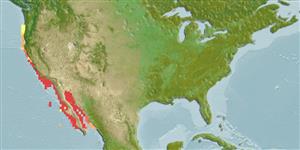Classification / Names
Common names from other countries
Main reference
Size / Weight / Age
Max length : 152 cm TL male/unsexed; (Ref. 2850); max. published weight: 33.0 kg (Ref. 9330); max. reported age: 30 years (Ref. 33520)
Environment
Marine; brackish; demersal; oceanodromous (Ref. 51243); depth range 0 - 183 m (Ref. 2850)
Climate / Range
Subtropical, preferred 19°C (Ref. 107945); 48°N - 24°N
Distribution
Eastern Pacific: Quillayute River in northern Washington, USA to southern Baja California, Mexico. Also in northern the Gulf of California (Ref. 9330).
Countries | FAO areas | Ecosystems | Occurrences | Introductions
IUCN Red List Status (Ref. 115185)
Threat to humans
Traumatogenic (Ref. 13513)
Human uses
Fisheries: commercial; gamefish: yes
More information
ReferencesAquacultureAquaculture profileStrainsGeneticsAllele frequenciesHeritabilityDiseasesProcessingMass conversion
Tools
Special reports
Download XML
Internet sources
Estimates of some properties based on models
Phylogenetic diversity index
PD50 = 0.5000 many relatives (e.g. carps) 0.5 - 2.0 few relatives (e.g. lungfishes)
Trophic Level
4.5 ±0.63 se; Based on food items.
Resilience
Low, minimum population doubling time 4.5 - 14 years (K=0.08; tmax=30; tm=3)
Vulnerability
High to very high vulnerability (68 of 100)
Price category
